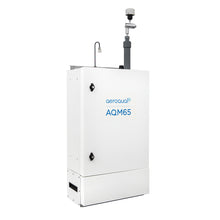
Aeroqual AQM 65 Ambient Air Monitoring Station
With the AQM 65, you can continuously measure common air pollutants including ozone (O3), nitrogen dioxide (NO2), nitrogen oxides (NOx), carbon monoxide (CO), sulfur dioxide (SO2), volatile organic compounds (VOC), hydrogen sulfide (H2S), carbon dioxide (CO2), particulate matter (TSP, PM10, PM2.5, PM1), noise and meteorological parameters such as rainfall, temperature, humidity, pressure, wind speed, and direction.
Linked together in a network, and coupled with remote data acquisition, AQM 65s will form a lower cost, high-density ambient pollution monitoring system for a city or industrial perimeter. With near reference levels of performance, the AQM 65 ensures air quality data is reliable and robust and traceable back to recognized international standards e.g. USEPA (40 CFR Part 53) and EU (2008/50/EC).
The compact size has numerous advantages. The unit can be transported by car, carried by two people, and installed and operational in under 30 minutes. This makes deployment and relocation quick and easy. It also opens up monitoring locations that were previously inaccessible to traditional monitoring stations. Because the enclosure is small, the energy required for temperature control is much lower than for a traditional monitoring station. Lower power consumption opens up the possibility of a remote power supply and further decreases the total cost of ownership.
The modular design of the AQM 65 increases flexibility and makes maintenance and servicing easy. Order your AQM 65 with as many or as few sensors as you like – then purchase additional sensors when you need them. The sensors, packaged in modules, can be individually removed from the enclosure and sent away for servicing or simply swapped out for a new one. Such convenience decreases downtime and lowers the total cost of ownership. In a network, you can also move sensor modules from one monitoring location to another according to your needs.
Unlike other sensor-based instruments the AQM 65 is designed to be calibrated using standard calibration equipment used to calibrate ambient air quality analyzers. This ensures your measurements will be robust and traceable back to reference standards. We also offer calibration equipment specifically designed for the AQM 65 – the AirCal 1000 portable calibrator and the AirCal 8000 which comes fully integrated with your AQM 65 system.
The AQM 65 is supported by a global distribution network, meaning you’re never too far from a skilled technician ready to provide assistance and spare parts. In addition, Aeroqual’s online training system is free to all our customers, meaning you can become an expert on your AQM system before it even arrives.
Once the instrument operating system is installed- Aeroqual Connect – lets you access data, assess performance and diagnose faults remotely (if you choose to give us access, we can help with that too). Aeroqual Cloud offers even greater levels of convenience with enhanced browsing speeds, multiple user management, fail-safe backup, email and SMS alerts and access to your data even when your instrument is offline.
Features:
Continuously measure up to 10 common air pollutants
Continuously monitor up to 10 different environmental parameters
Small size opens up new monitoring locations
Install and start measuring in under an hour
Measure, log, report and respond all in real-time
Retrieve data remotely via a direct internet connection or cloud-based interface
Remotely configure, diagnose, and adapt via an online user interface
Modular design allows for ease of maintenance and repairs
Integrated automated calibration optional
Traceable back to USEPA (40 CFR Part 53) and EU (2008/50/EC) certified equivalent method instruments
1ppb detection of O3, NO2, NOx; <10ppb for SO2, H2S, and VOCs
Applications:
Urban air monitoring networks
National air monitoring networks
Roadside air monitoring
Industrial perimeter monitoring
Environmental impact assessments
Research and consultancy projects
Short term hot spot monitoring
| Control System | Embedded fanless PC, Intel Atom N2600, 1.6GHz, 2GB RAM, 32GB SSD, Ubuntu Linux |
| Communications | Standard: WIFI, Ethernet (LAN) Optional: Cellular IP GPRS modem |
| Gas Sampling System Inlet | Inlet: Teflon, glass-coated stainless steel Pump: 12V brushless DC diaphragm |
| Thermal Management System | Direct current compressor, R134a refrigerant, 12-24V 60W resistance heater |
| Software | Connect: runs on embedded PC, accessed via web browser (IE, Firefox, Chrome, Safari) Cloud: runs on secure ‘cloud’ servers, accessed via web browser Connect / Cloud Features: configuration, diagnostics, journal, calibration and data acquisition, plus SMS and email alerts (optional), and auto data export via FTP and email (optional) |
| Power Requirements | 90*-264VAC, 47-63Hz Typical draw: 100W** (depends on configuration and ambient temperature) |
| Enclosure | Outer: IP65 rated aluminium skin with solar reflective coating Inner: 40-50 mm layer of cross-linked PE foam insulation |
| Dimensions | Standard: 1310Hx510Wx280D mm (includes inlet) With AirCal 8000: 1310Hx655WX280D mm Weight (installed): 30 Kg** |
| Environmental Operating Range | Temperature: -35°C to +50°C |
| Gas Calibration (optional) | Portable: AIRCAL 1000 with gas dilution module and zero air source Integrated: AIRCAL 8000 integrated system with gas dilution module, zero air source, 2 x regulators and span gas storage (excl. gas cylinders) |
| Factory Integrated & Tested Sensors (optional) | Gill WindSonic (ultrasonic wind sensor) Vaisala WXT520 (weather transmitter) Met One MSO (weather transmitter) Cirrus MK427 Class 1 (noise monitor) Novalynx Pyranometer (solar radiation) |
| *Power supply efficiency derates at high ambient T (>50°C). Need 110VAC minimum at above 50°C. **Configuration used for power consumption and weight: Embedded PC, Sample Pump, System Manager, NOx, NO2, O3, CO, PM10 + inlet heater, SO2, H2S (43W internal load); Internal temperature set point = 30°C, Ambient temperature used is 30°C. |






